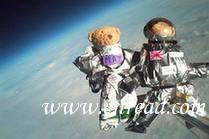| ||||||||||||||||||||||||||||||||||||||||
|
本周一,英国剑桥大学太空飞行俱乐部的学生们利用一只氦气球,将4只泰德玩具熊送到距离地面30公里的太空,并让这4名“玩具宇航员”进行“太空漫步”。它们身着的四套“泰迪熊太空服”均由当地的中学生设计,而此次“太空漫步”实验就是为了检验这四套“太空服”在-53℃的低温条件下保护泰迪熊的能力。此外,太空专家们也希望通过这样的活动让学生们尽早参与到科技活动中来。 This Cambridge University press office (CUPO) handout1 shows two of the four teddy bears that were lauched to the edge of space. Four teddy bears, fully2 decked out in custom-made spacesuits, were launched to the edge of space this week as part of a British university experiment. Four teddy bears, fully decked out in custom-made spacesuits, were launched to the edge of space this week as part of a British university experiment. Blasting off from Cambridge University's Churchill College on Monday, they were attached to a helium balloon and fitted with multiple cameras, a GPS receiver, flight computer and radio for the two-hour nine-minute flight, which saw them rise 30 kilometres (18.8 miles) above sea level. The spacesuits were designed by local schoolchildren, as part of a project to engage youths in science and engineering, organised by the Cambridge University Spaceflight student club. CU Spaceflight said the aim of the experiment was to find out which of the four spacesuits, each designed by a different group of students, best insulated the cuddly3 toys from the -53 degrees Celcius (-63 degrees Fahrenheit) temperatures. "We want to offer young people the opportunity to get involved in the space industry whilst still at school and show that real-life science is something that is open to everybody," said Iain Waugh, CU Spaceflight's chief aeronautical4 engineer. "High altitude balloon flights are a fantastic way of encouraging interest in science. They are easy to understand, and produce amazing results." A Cambridge University spokeswoman noted5: "No treasured possessions were endangered in this experiment." 点击  收听单词发音 收听单词发音
|
||||||||||||||||||||||||||||||||||||||||
- 发表评论
-
- 最新评论 进入详细评论页>>




